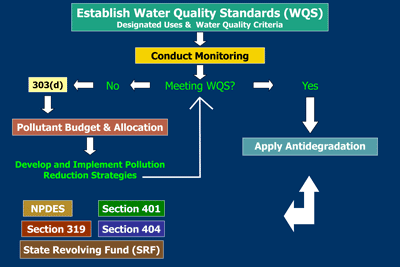Monitoring
First, water quality standards (WQS) consistent with the statutory goals of the CWA must be established. Then water bodies should be monitored to determine whether the WQS are being met. The responsibility for ambient monitoring of rivers, lakes, bays, wetlands, estuaries, and nearshore marine waters falls primarily on the states. Contrary to what many believe, EPA does not operate a large national network of water quality monitoring stations, though it could be involved in numerous monitoring projects across the country at any given time.
Unfortunately, most states do not have the funding required to carry out ambient monitoring on the scale needed to keep close track of the condition of our nation’s surface waters. Most of the waters in the United States are not monitored several times a year or even once over a period of several years
To be virtually certain that WQS are being met, instruments capable of performing continuous monitoring and analysis would need to be employed. Unfortunately, this is rarely the case, particularly for certain types of pollutants like synthetic organic chemicals. On the other hand, considerably less data is needed to have strong evidence that WQS are not being met (i.e.,WQC are exceeded.) This asymmetry in the amount of data needed is due simply to the severe harm that can come to aquatic ecosystems (and virtually all forms of life) from brief (minutes, hours) exposure to high levels of contaminants. Hence, proving that such short-term conditions occurred at no time over a given period of years requires essentially continuous monitoring.
On the other hand, if available data represent only a small fraction of the time period in question, and those limited data points include one or more exceedances of specified magnitude/duration and frequency combinations, then simple probability tells us that collecting a substantial number of additional samples will reveal additional exceedances. Therefore, we can be confident that WQS are being exceeded several times instream during the specified periods.

![[logo] US EPA](https://www.epa.gov/epafiles/images/logo_epaseal.gif)